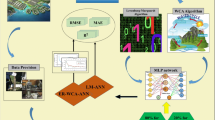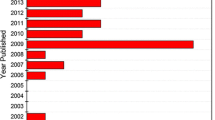Abstract
Assessment of parameter and predictive uncertainty of hydrologic models is an essential part in the field of hydrology. However, during the past decades, research related to hydrologic model uncertainty is mostly done with conceptual models. As is accepted that uncertainty in model predictions arises from measurement errors associated with the system input and output, from model structural errors and from problems with parameter estimation. Unfortunately, non-conceptual models, such as black-box models, also suffer from these problems. In this paper, we take the artificial neural network (ANN) rainfall-runoff model as an example, and the Shuffled Complex Evolution Metropolis algorithm (SCEM-UA) is employed to analysis the parameter and predictive uncertainty of this model. Furthermore, based on the results of uncertainty assessment, we finally arrive at a simpler incomplete-connection artificial neural network (ICANN) model as well as with better performance compared to original ANN rainfall-runoff model. These results not only indicate that SCEM-UA can be a useful tool for uncertainty analysis of ANN model, but also prove that uncertainty does exist in ANN rainfall-runoff model. Additionally, in some way, it presents that the ICANN model is with smaller uncertainty than the original ANN model.





























Similar content being viewed by others
References
Ajami NK, Duan Q, Sorooshian S (2007) An integrated hydrologic bayesian multi-model combination framework: confronting input, parameter and model structural uncertainty. Water Resour Res 43:W01403
Ajami NK, Hornberger GM, Sunding DL (2008) Sustainable water resource management under hydrological uncertainty. Water Resour Res 44:W11406
Aksoy H, Dahamsheh A (2009) Artificial neural network models for forecasting monthly precipitation in Jordan. Stoch Environ Res Risk Assess 23:917–931
Aqil M, Kita I, Yano A, Nishiyama S (2007) A comparative study of artificial neural networks and neuro-fuzzy in continuous modeling of the daily and hourly behaviour of runoff. J Hydrol 337:22–34
Bates BC, Campbell EP (2001) A Markov chain Monte Carlo scheme for parameter estimation and inference in conceptual rainfall-runoff modeling. Water Resour Res 37:937–947
Beven KJ (2001) Rainfall-runoff modelling—the primer. Wiley, Hoboken
Beven K (2006) A manifesto for the equifinality thesis. J Hydrol 320:18–36
Beven KJ, Binley AM (1992) The future of distributed models: model calibration and uncertainty prediction. Hydrol Process 6:279–298
Beven KJ, Smith PJ, Freer JE (2008) So just why would a modeler choose to be incoherent. J Hydrol 354:15–32
Blasone RS, Vrugt JA, Madsen H, Rosbjerg D, Robinson BA, Zyvoloski GA (2008) Generalized likelihood uncertainty estimation (GLUE) using adaptive Markov Chain Monte Carlo sampling. Adv Water Res 31:630–648
Box GEP, Tiao GC (1973) Bayesian inference in statistical analysis. Addison-Wesley-Longman, Massachusetts
Boyle DP, Gupta HV, Sorooshian S (2000) Toward improved calibration of hydrological models: combining the strengths of manual and automatic methods. Water Resour Res 36:3663–3674
Butts MB, Payne JT, Kristensen M, Madsen H (2004) An evaluation of the impact of model structure on hydrological modeling uncertainty for streamflow simulation. J Hydrol 298:242–266
Cheng CT, Lin JX, Sun YG, Chau K (2005) Long-term prediction of discharges in manwan hydropower using adaptive-network-based fuzzy inference systems models. Lecture Notes in Computer Science 3612:1152–1161
Cheng CT, Xie JX, Chau KW, Layeghifard M (2008) A new indirect multi-step-ahead prediction model for a long-term hydrologic prediction. J Hydrol 361:118–130
Chiang S, Tachikawa Y, Takara K (2007) Hydrological model performance comparison through uncertainty recognition and quantification. Hydrol Process 21:1179–1195
Diks CGH, Vrugt JA (2010) Comparison of point forecast accuracy of model averaging methods in hydrologic applications. Stoch Environ Res Risk Assess 24:809–820
Duan Q, Sorooshian S, Gupta VK (1992) Effective and efficient global optimization for conceptual rainfall-runoff models. Water Resour Res 28:1015–1031
Feyen L, Gorelick SM (2004) Framework to evaluate the worth of hydraulic conductivity data for optimal groundwater resources management in ecologically sensitive areas. Water Resour Res 41:W03019
Feyen L, Vrugt JA, Nuallain BO, van der Knijff J, De Roo A (2007) Parameter optimisation and uncertainty assessment for large-scale streamflow simulation with the LISFLOOD model. J Hydrol 332:276–289
Freer J, Beven KJ, Ambroise B (1996) Bayesian estimation of uncertainty in runoff prediction and the value of data: an application of the GLUE approach. Water Resour Res 32:2161–2173
Gao C, Gemmer M, Zeng X, Liu B, Su B, Wen Y (2010) Projected streamflow in the Huaihe River Basin (2010–2100) using artificial neural network. Stoch Environ Res Risk Assess 24:685–697
Gelman A, Rubin DB (1992) Inference from iterative simulation using multiple sequences. Stat Sci 7:457–472
Georgekakos KP, Seo DJ, Gupta H, Schaake J, Butts MB (2004) Characterizing streamflow simulation uncertainty through multimodel ensembles. J Hydrol 298:222–241
Gupta HV, Sorooshian S, Yapo PO (1998) Toward improved calibration of hydrologic models: multiple and noncommensurable measures of information. Water Resour Res 34:751–763
Gupta HV, Beven KJ, Wagener T (2005) Model calibration and uncertainty estimation. In: Anderson MG et al. (eds) Encyclopedia of hydrological sciences. Wiley, Chichester, pp 1–17
Hagan MT, Menhaj MB (1994) Training feed forward networks with the Marquaradt algorithm. IEEE Trans Neural Netw 5:861–867
Heidari A, Saghafian B, Maknoon R (2006) Assessment of flood forecasting lead time based on generalized likelihood uncertainty estimation approach. Stoch Environ Res Risk Assess 20:363–380
Islam MN, Sivakumar B (2002) Characterization and prediction of runoff dynamics: a nonlinear dynamical view. Adv Water Res 25:179–190
Karamouz M, Razavi S, Araghinejad S (2008) Long-lead seasonal rainfall forecasting using time-delay recurrent neural networks: a case study. Hydrol Process 22:229–241
Keesman KJ (1990) Set theoretic parameter estimation using random scanning and principal component analysis. Math Comput Simul 32:535–543
Kisi O (2009a) Neural networks and wavelet conjunction model for intermittent streamflow forecasting. J Hydrol Eng 14:773–782
Kisi O (2009b) Wavelet regression model as an alternative to neural networks for monthly streamflow forecasting. Hydrol Process 23:3583–3597
Klepper O, Scholten H, van de Kamer JPG (1991) Prediction uncertainty in an ecological model of the Oosterschelde Estuary. J Forecast 10:191–209
Kuczera G, Parent E (1998) Monte Carlo assessment of parameter uncertainty in conceptual catchment models: the Metropolis algorithm. J Hydrol 211:69–85
Lippmann RP (1987) An introduction to computing with neural nets. IEEE ASSP Mag 3:4–22
Madsen H (2000) Automatic calibration of a conceptual rainfall-runoff model using multiple objectives. J Hydrol 235:276–288
Madsen H (2003) Parameter estimation in distributed hydrological catchment modelling using automatic calibration with multiple objectives. Adv Water Res 26:205–216
Mantovan P, Todini E (2006) Hydrological forecasting uncertainty assessment: incoherence of the GLUE methodology. J Hydrol 330:368–381
Marshall L, Nott D, Sharma A (2004) A comparative study of Markov chain Monte Carlo methods for conceptual rainfall-runoff modeling. Water Resour Res 40:W02501
Marshall LA, Nott DJ, Sharma A (2006) Towards dynamic catchment modelling: a Bayesian hierarchical mixtures of experts framework. Hydrol Process 21:847–861
McMillan H, Clark M (2009) Rainfall-runoff model calibration using informal likelihood measures within a Markov chain Monte Carlo sampling scheme. Water Resour Res 45:W04418
Misirli F (2003) Improving efficiency and effectiveness of Bayesian recursive parameter estimation for hydrological models. PhD Dissertation, Department of Hydrology and Water Resources, University of Arizona, Tucson, AZ
Moradkhani H, Hsu KL, Gupta H, Sorooshian S (2005) Uncertainty assessment of hydrologic model states and parameters: sequential data assimilation using the particle filter. Water Resour Res 41:W05012
Nayak PC, Sudheer KP, Rangan DM, Ramasastri KS (2004) A neuro-fuzzy computing technique for modeling hydrological time series. J Hydrol 291:52–66
Neuman SP (2003) Maximum likelihood Bayesian averaging of uncertain model predictions. Stoch Environ Res Risk Assess 17:291–305
Schoups G, Vrugt JA (2010) A formal likelihood function for parameter and predictive inference of hydrologic models with correlated, heteroscedastic, and non-Gaussian errors. Water Resour Res 46:W10531
Schoups G, van de Giesen NC, Savenije HHG (2008) Model complexity control for hydrologic prediction. Water Resour Res 44:W00B03
Sorooshian S, Duan Q, Gupta VK (1993) Calibration of rainfall-runoff models: application of global optimization to the Sacramento Soil Moisture accounting model. Water Resour Res 29:1185–1194
Stedinger JR, Vogel RM, Lee SU, Batchelder R (2008) Appraisal of the generalized likelihood uncertainty estimation (GLUE) method. Water Resour Res 44:W00B06
Tang Y, Reed P, Wagener T (2005) How effective and efficient are multiobjective evolutionary algorithms at hydrologic model calibration. Hydrol Earth Syst Sci Discuss 2:2465–2520
Thiemann M, Trosset M, Gupta HV, Sorooshian S (2001) Bayesian recursive parameter estimation for hydrological models. Water Resour Res 37:2521–2535
Tsai FT (2010) Bayesian model averaging assessment on groundwater management under model structure uncertainty. Stoch Environ Res Risk Assess 24:845–861
van Straten G, Keesman KJ (1991) Uncertainty propagation and speculation in projective forecasts of environmental change: a lake eutrophication example. J Forecast 10:163–190
Vrugt JA, Robinson BA (2007) Treatment of uncertainty using ensemble methods: comparison of sequential data assimilation and Bayesian model averaging. Water Resour Res 43:W01411
Vrugt JA, Weerts AH, Bouten W (2001) Information content of data for identifying soil hydraulic parameters from outflow experiments. Soil Sci Soc Am J 65:19–27
Vrugt JA, Gupta HV, Bastidas LA, Bouten W, Sorooshian S (2003a) Effective and efficient algorithm for multi-objective optimization of hydrologic models. Water Resour Res 39:1214
Vrugt JA, Gupta HV, Bouten W, Sorooshian S (2003b) A Shuffled Complex Evolution Metropolis algorithm for optimization and uncertainty assessment of hydrologic model parameters. Water Resour Res 39:1201
Vrugt JA, Schoups GH, Hopmans JW, Young CH, Wallender W, Harter T, Bouten W (2004) Inverse modeling of largescale spatially distributed vadose zone properties using global optimization. Water Resour Res 40:W06503
Vrugt JA, Diks CGH, Gupta HV, Bouten W, Verstraten JM (2005) Improved treatment of uncertainty in hydrologic modeling: combining the strengths of global optimization and data assimilation. Water Resour Res 41:W01017
Vrugt JA, Clark MP, Diks CGH, Duan Q, Robinson BA (2006) Multi-objective calibration of forecast ensembles using Bayesian model averaging. Geophys Res Lett 33:L19817
Vrugt JA, Diks CGH, Clark MP (2008a) Ensemble Bayesian model averaging using Markov Chain Monte Carlo sampling. Environ Fluid Mech 8:579–595
Vrugt JA, ter Braak CJF, Gupta HV, Robinson BA (2008b) Equifinality of formal (DREAM) and informal (GLUE) Bayesian approaches to hydrologic modeling. Stoch Environ Res Risk Assess 23:1059–1060
Wagener T, Gupta HV (2005) Model identification for hydrological forecasting under uncertainty. Stoch Environ Res Risk Assess 19:378–387
Wang WC, Chau KW, Cheng CT, Qiu L (2009) A comparison of performance of several artificial intelligence methods for forecasting monthly discharge time series. J Hydrol 374:294–306
Wang W, Cheng C, Qiu L, Yang B (2010) Effective optimization and uncertainty assessment of Xin’anjiang model parameters. Eng Sci 12(100–107):112
Willems P (2005) Uncertainties in rainfall–runoff modeling. Water Encycl 5:297–304
Yapo PO, Gupta HV, Sorooshian S (1998) Multi-objective optimization for hydrologic models. J Hydrol 204:83–97
Acknowledgments
The authors thank Professor Jasper A. Vrugt for recommending this topic for research as well as providing the source code of the SCEM-UA algorithm and the data used in the application. Also, special thanks are given to the anonymous reviewers and editors for their constructive comments. This work is supported by the Special Research Foundation for the Public Welfare Industry of the Ministry of Water Resources (Project No. 201001080) and the research funds of University and college PhD discipline of China (No. 20100142110012).
Author information
Authors and Affiliations
Corresponding author
Rights and permissions
About this article
Cite this article
Guo, J., Zhou, J., Song, L. et al. Uncertainty assessment and optimization of hydrological model with the Shuffled Complex Evolution Metropolis algorithm: an application to artificial neural network rainfall-runoff model. Stoch Environ Res Risk Assess 27, 985–1004 (2013). https://doi.org/10.1007/s00477-012-0639-0
Published:
Issue Date:
DOI: https://doi.org/10.1007/s00477-012-0639-0




